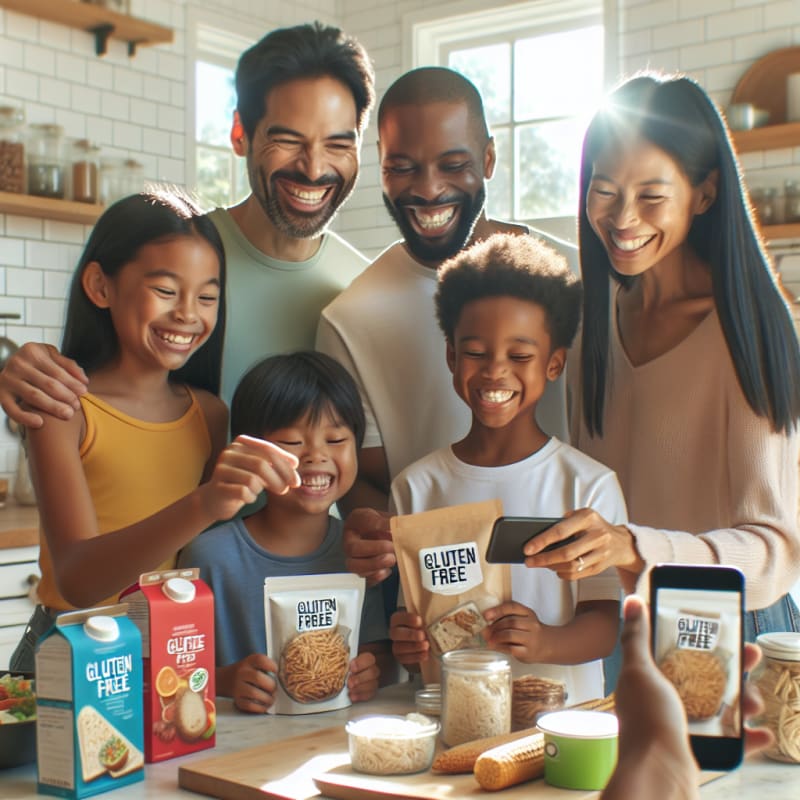Scan Your Food For Gluten – Here’S How
By Generic Scanners Editorial Team
A Parent’s Dilemma: Navigating Gluten in Everyday Meals
“It happened again,” recalls Sarah, a mother in Chicago. “We thought the pasta was gluten-free, but my son’s stomach told us otherwise.” For millions of families, deciphering food labels for hidden gluten is a daily challenge. Whether you’re managing celiac disease, gluten sensitivity, or simply exploring a gluten-free lifestyle, the question remains: How can you reliably scan your food for gluten?
Understanding Gluten: Why Detection Matters
Gluten, a protein found in wheat, barley, and rye, can trigger severe reactions in sensitive individuals. According to the U.S. Food & Drug Administration (FDA), even trace amounts may cause symptoms in those with celiac disease.[1] The European Food Safety Authority (EFSA) echoes similar warnings for EU consumers.[2]
- Celiac disease affects 1 in 100 people worldwide (PubMed).[3]
- Non-celiac gluten sensitivity is increasingly recognized, though diagnosis remains complex.
- Symptoms range from digestive distress to neurological effects.
Scan Your Food For Gluten – Here’s How
Advances in technology now allow consumers to scan food products for gluten content—directly from their smartphones. The process combines ingredient analysis, regulatory databases, and AI-powered recognition for instant answers.
| Method | How It Works | Pros | Cons |
|---|---|---|---|
| Manual Label Reading | Check for “gluten-free” claims and allergen statements | Accessible, no tech needed | Time-consuming, prone to error |
| Barcode Scanning Apps | Scan barcode, app checks gluten status in database | Fast, accurate, up-to-date | Dependent on database quality |
| Ingredient Recognition AI | App uses camera to read ingredients and flag gluten | Works on unpackaged foods, global use | May miss obscure gluten sources |
| Lab Testing Kits | Test food samples for gluten proteins | Scientific accuracy | Expensive, not practical for daily use |
Food Scan Genius: Your Smart Gluten Detector
Food Scan Genius is a leading app designed for people with food sensitivities, allergies, and dietary preferences. Using AI and up-to-date regulatory databases, it allows users to:
- Scan product barcodes to instantly check for gluten and other allergens
- Analyze ingredient lists using your phone’s camera—even for international products
- Access regulatory info from the FDA, EFSA, and more
- Track dietary preferences for vegan, kosher, halal, and other needs
“Food Scan Genius changed the way I shop. I scan everything for gluten, and the app even alerts me to hidden sources I’d never spot on my own. My family feels safer, and I spend less time worrying.”
— Emily R., London
Download Food Scan Genius today to scan your food for gluten—here’s how you take control of your diet.
Regulations: US vs EU Gluten Labeling Laws
| Region | Authority | Gluten-Free Standard | Mandatory Allergen Labeling |
|---|---|---|---|
| United States | FDA | <20 ppm gluten | Wheat disclosure required; gluten not always specified |
| European Union | EFSA | <20 ppm gluten | Wheat, barley, rye, oats must be labeled; gluten highlighted |
In the US, the FDA mandates that foods labeled “gluten-free” contain less than 20 parts per million (ppm) of gluten.[1] However, “wheat-free” does not always mean “gluten-free.” In the EU, EFSA requires explicit labeling of gluten-containing cereals, with allergens highlighted in bold.[2]
- US shoppers must look for “gluten-free” claims and check ingredient lists for wheat, barley, rye.
- EU consumers benefit from stricter allergen disclosure, but vigilance is still required for processed foods.
News outlets like The New York Times and BBC News have recently highlighted confusion around gluten labeling and the rise of digital solutions.[4][5]
How AI and Scanning Apps Work: Step-by-Step
- Open your scanning app (e.g., Food Scan Genius)
- Scan the barcode or ingredient list with your phone’s camera
- App matches product to regulatory databases (FDA, EFSA, etc.)
- AI flags gluten-containing ingredients (wheat, barley, rye, malt, etc.)
- Instant result: “Gluten-free” or “Contains gluten”
This process is optimized for mobile use, with clear spoken feedback for voice assistants. Apps like Food Scan Genius are designed to support accessibility, making gluten detection easier for all users.
Common Hidden Sources of Gluten
- Malt (often found in cereals, candy, beer)
- Modified food starch (may contain wheat)
- Hydrolyzed vegetable protein (source varies)
- Seasonings and sauces (soy sauce, dressings)
- Processed meats (fillers, binders)
Scientific studies confirm that gluten can appear in unexpected places, making scanning technology essential for safe eating.[3]
Q&A: Scan Your Food For Gluten – Here’s How
Q: Is scanning for gluten more reliable than reading labels?
A: Yes—scanning apps like Food Scan Genius combine real-time regulatory data, ingredient recognition, and AI to catch hidden gluten sources that may be missed by manual reading. This reduces human error and speeds up shopping.
Q: Can I use scanning apps internationally?
A: Most leading apps, including Food Scan Genius, support US and EU labeling standards and update databases for global products. Always check for local regulations.
Q: What if the product is homemade or unpackaged?
A: AI-powered ingredient recognition can scan written or printed ingredient lists. For homemade foods, ask for a full ingredient breakdown or use a portable gluten testing kit.
Q: How do I know if an app’s database is trustworthy?
A: Look for apps that cite regulatory authorities (FDA, EFSA) and update their databases regularly. User reviews and transparency are also key.
Best Practices for Safe Gluten-Free Shopping
- Always scan before purchasing—especially for processed and imported foods
- Check for “gluten-free” certification (US: FDA, EU: EFSA)
- Review ingredient lists for hidden sources
- Use trusted scanning apps like Food Scan Genius
- Stay informed via news outlets and regulatory updates
Conclusion: Empower Your Diet with Smart Scanning
Sarah’s story is familiar to many. But with scanning technology and a better understanding of international labeling laws, families can confidently navigate dietary challenges. Food Scan Genius empowers users to scan their food for gluten—here’s how you protect your loved ones and enjoy peace of mind.
Download Food Scan Genius and make gluten detection part of your daily routine.
References
Frequently Asked Questions
- How accurate are gluten scanning apps? Most apps are highly accurate when updated regularly and based on official regulatory data.
- Can Food Scan Genius detect other allergens? Yes, it supports multiple allergen detection, including nuts, dairy, soy, and more.
- Is Food Scan Genius available worldwide? Yes, with support for US and EU standards and growing international coverage.





